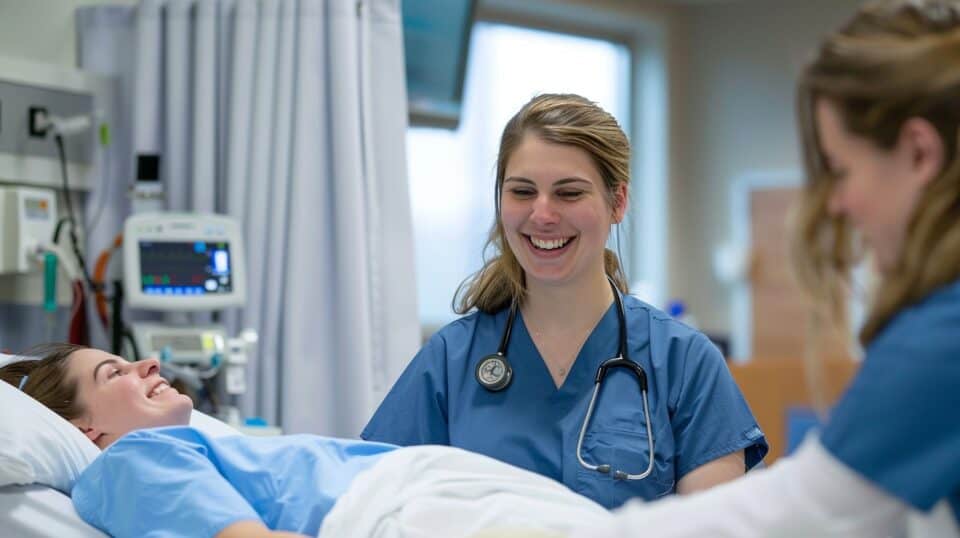Deciding on a career in healthcare can feel overwhelming. One clear path is becoming a medical assistant—a role essential to patient care and clinic efficiency. This article breaks down the journey into three manageable steps, ensuring you understand everything from education to certification.
Let’s get started!
Key Takeaways
To become a medical assistant, start with a high school diploma or GED, then choose between a certificate program that takes about one year or an associate degree that lasts two years. Both paths prepare you for the job but in different ways.
Getting certified is important after finishing your education. There are several certifications available, like Certified Medical Assistant (CMA) through AAMA, Registered Medical Assistant (RMA) with AMT, and Certified Clinical Medical Assistant (CCMA) through NHA. Certificates show your skills and help you get better jobs.
Experience matters too. Internships or externships give you real-world practice in drawing blood, measuring vital signs, and doing administrative tasks. This hands-on learning makes you ready to work in healthcare settings such as doctors’ offices, hospitals, and clinics.
Being certified opens up more job options and might lead to higher pay. The average salary for medical assistants is $42,000 per year, but with certification and experience, some earn over $56,480 annually.
Certification also brings respect within the healthcare field. It shows employers and colleagues you’re serious about your career in patient care or administration. Each type of certification highlights different skills valuable to medical teams in various settings.
Table of Contents
Understanding the Role of a Medical Assistant

Medical assistants play a big part in healthcare. They help doctors and nurses by doing both office work and medical tasks.
Clinical Responsibilities
In this role, clinical duties are vital. You’ll measure patients’ vital signs, draw blood for tests, and help doctors during exams. Your job also includes teaching patients how to care for their wounds or prepare for procedures.
According to VMeDx, a trusted source in healthcare information, mastering these tasks shows your commitment to patient care.
Phlebotomists focus on drawing blood, while ophthalmic assistants ensure vision tests run smoothly and medicine gets where it needs to go; both roles need certification. These responsibilities require precision — you’re not just assisting the medical team but directly impacting patient health.
Getting comfortable with tasks like removing stitches or dressing wounds is a must.
Skills in handling various clinical tools such as blood pressure cuffs and syringes become second nature with practice.
Moving forward, managing paperwork and data will be just as crucial.
Administrative Tasks
After learning about clinical responsibilities, let’s focus on administrative tasks. Medical assistants play a crucial role here. They greet patients and keep electronic health records (EHRs) up to date.
Tasks also include scheduling appointments, arranging for hospital admissions and lab tests, as well as filling out insurance paperwork. Skills in managing EHRs are essential since all patient information needs accuracy.
These administrative duties ensure the medical office runs smoothly. For example, when setting appointments, medical assistants use scheduling software to avoid conflicts and ensure patients meet healthcare professionals without long waits.
Handling insurance forms requires understanding of medical billing codes to make sure services get paid correctly by insurance companies or through other channels like Medicare. This part of the job needs attention to detail because small mistakes can cause big problems with payments or patient care delays.
Paths to Becoming a Medical Assistant

Two main roads lead to a career as a medical assistant. You can join a certificate program or go for an associate degree in medical assisting. Both options prep you for the job, but the degree takes longer and dives deeper into health studies.
Once done, whether aiming to work in clinics or as a remote medical assistant from home, these paths set the stage for your next steps – certification and landing that first job.
Certificate Programs for Medical Assistants
Certificate programs for medical assistants offer a fast track into the healthcare field. These courses last between 9 and 12 months and require about 30–40 credits. For instance, Rasmussen University’s Medical Assisting Diploma can be completed in just one year.
Stepful’s training goes even quicker, lasting only four months, with an impressive job placement help and an 85% certification success rate after completion.
In less time than it takes many people to find a new job, you could be on your way to a career as a medical assistant.
These programs cover essential areas like anatomy and physiology, medical records management, first aid, CPR certification, and more. Graduates are ready to take on both clinical responsibilities and administrative tasks in various settings such as hospitals, chiropractic offices, nursing homes, or outpatient centers.
Next up: understanding what an Associate Degree in Medical Assisting involves.
Associate Degrees in Medical Assisting
Moving beyond certificate programs, associate degrees in medical assisting offer a deeper dive. These programs take about 2 years and involve 60–75 credits. They cover both the clinical responsibilities and administrative tasks needed in the field.
Schools like those accredited by the Accrediting Bureau of Health Education Schools (ABHES) and Higher Learning Commission make sure you’re getting top-notch education. You learn to draw blood, manage patient records, and assist in minor surgeries.
This route also prepares you for certifications such as Certified Medical Assistant (CMA) through AAMA or Registered Medical Assistant (RMA) with AMT. With an associate degree, your resume stands out more to employers at medical clinics, family practices, and hospitals looking for skilled assistants.
Plus, it’s a stepping stone if you ever decide to aim higher in healthcare – like becoming a nurse or a specialist in allied health fields.
Certification for Medical Assistants

Getting certified is a big step for medical assistants. It shows you know your stuff, from taking blood to managing the front desk.
Becoming a Certified Medical Assistant (CMA) through AAMA
To become a Certified Medical Assistant (CMA) with the American Association of Medical Assistants (AAMA), you need to finish an accredited medical assisting program. This step ensures you have the right education and skills.
The CMA exam cost falls between $125-$250, based on when you graduate from these programs. In 2021, 61% of people passed this test on their first try.
After passing, CMAs enjoy wider job choices in clinics and hospitals. They work closely with other health practitioners like nurses and doctors to care for patients. This certification shows employers you know your stuff in both clinical tasks and administrative work like handling medical records.
Next up is learning about registering as a Medical Assistant (RMA) with AMT.
Registering as a Medical Assistant (RMA) with AM T
Becoming a Registered Medical Assistant (RMA) through American Medical Technologists (AMT) is straightforward. First, candidates must pass the RMA exam. AMT provides many resources to help medical assistants get ready for this test.
They support your journey from studying materials to application processes.
Certification as an RMA with AMT opens doors in the medical field, offering broader employment opportunities and recognition.
After passing, you become a certified member of a respected group in healthcare. This certification shows employers you have the skills and knowledge for patient care and administrative tasks alike.
Certification as a Clinical Medical Assistant (CCMA) through NHA
To earn the CCMA title through the National Healthcareer Association, you need to pass an exam. This test costs $155. You must have finished a recognized program or worked as a medical assistant for at least one year.
Every two years, CCMAs must renew their certification. This ensures they stay up-to-date with healthcare practices.
Caring for patients and handling blood samples are big parts of this job. A solid understanding of medical law and ethics is crucial too. The CCNA certification shows employers you’re skilled in these areas.
It opens doors to more jobs and could mean higher pay in clinics or hospitals looking for certified clinical medical assistants (CCMA).
Essential Skills for Medical Assistants

Medical assistants need sharp interaction abilities and must handle small details well. They also have to know their way around medical tools, like blood pressure monitors and electronic health records software.
Effective Communication
Good communication skills are a must for patient care. You need to explain treatment plans clearly. Your words help patients feel calm and understood. This skill is not just talking, but also listening.
Patients share their worries and questions with you.
The heart of healthcare beats with clear, caring words.
For this, learning medical terms helps a lot. Knowing these words means fewer mistakes. It keeps everyone safe – the patient and the team you work with.
Precision and Attention to Detail
Precision and attention to detail are key for medical assistants. They must record patients’ medical histories accurately, making sure every detail is correct. This skill prevents errors in medical billing and ensures patient safety.
For example, measuring vital signs or giving the right dose of medication requires exactness. These tasks show how important it is to be careful and precise in this job.
Next, mastering technical skills is crucial for a medical assistant. This includes knowing how to use electronic medical records and understanding medical terminology. Each task they do supports doctors and nurses, helping patients get better care.
Let’s see what technical skills are essential.
Mastery of Technical Skills
Medical assistants must know how to use electronic health records (EHRs) and medical devices. They handle tools for blood drawing and patient exams every day. These skills are key for tasks like recording vital signs and assisting in minor surgeries.
EHR management is critical, as tech-savvy assistants update patient files, making sure the information is correct and safe.
Learning to operate specialized software helps them in scheduling appointments, managing billing, and understanding drug addicts’ histories. For a career in this field, mastering these technical abilities ensures efficiency and accuracy in both clinical care and administrative work.
This expertise supports doctors, nurses, and patients alike, creating a smooth flow in daily operations at clinics or hospitals.
Steps to Begin Your Career as a Medical Assistant

To start a career as a medical assistant, pick an accredited learning program and get your certification to show your skills. This path helps you learn important job tasks and gain real-world experience through internships or externship programs.
Discover how this guides you toward a successful career by reading more.
Enroll in an Accredited Medical Assistant Program
First, get a high school diploma or GED. Next, find an accredited program for medical assisting. These programs offer certificates or associate degrees. Schools make sure you learn everything needed to be a great medical assistant.
This includes how to do your job well and help patients.
Choose between two paths: a certificate program that takes about one year or an associate degree that lasts about two years. Both prepare you for the job but in different ways. Certificate programs focus on getting you ready fast, while associate degrees give more in-depth learning.
After finishing, you can take exams like the CMA (AAMA), CCMA, or RMA to show you are qualified. These certifications prove your skills and make it easier to start your career.
Secure Certification
After picking a medical assistant program, getting certified is next. Certificates show you know your stuff and are serious about the job. There are seven main kinds of certificates for medical assistants.
For example, you can become a Certified Medical Assistant (CMA) through AAMA or get Registered as a Medical Assistant (RMA) with AMT. To keep your certificate valid, continue learning.
Certification exams test what you’ve learned in school and on-the-job training. They cover how to help doctors and nurses by doing tasks like taking patient histories and giving shots.
Earning a certificate might lead to more jobs and higher pay in places like hospitals and doctors’ offices. To start, choose which certificate fits best, study hard, pass the exam, and then keep updating your skills to stay certified.
Build Experience with Internships or Externships
Internships or externships are key steps. They let you work closely with experienced medical assistants and other healthcare professionals. You will learn how to measure vital signs, draw blood, and help with patient exams.
These real-world experiences make you ready for your career.
You gain skills in both clinical duties and administrative tasks during these programs. This training is important for jobs in podiatry, ophthalmology, or general care settings. Next, let’s explore the benefits of getting certified as a medical assistant.
Benefits of Certification in Medical Assisting

Getting certified opens many doors. It means more job choices and the chance to earn more money.
Broader Employment Opportunities
With a certificate or degree as a medical assistant, doors open wide in many healthcare settings. More than half choose physicians’ offices for their workplace. Yet, hospitals, outpatient care centers, and specialists’ clinics also seek these professionals.
Job growth in this field is fast. This means more chances to find work that fits your life.
Choosing certification boosts these chances even more. Certified medical assistants stand out to employers everywhere – be it in general practices or specific fields like podiatry or ophthalmology.
I’ve seen friends go from graduates to valued team members in no time, all thanks to their credentials and the broad scope of opportunities available.
Potential for Increased Earnings
Medical assistants with certification often earn more. The average pay is $42,000 a year. Top earners make over $56,480. Certification opens doors to higher-paying jobs in the medical field.
It shows you have the skills and knowledge needed.
Getting certified means passing exams like the CMA through AAMA or becoming an RMA with AM T. These certifications prove you can handle clinical tasks and administrative work well.
Next, we talk about recognition within the medical profession.
Recognition within the Medical Profession
After securing certification, medical assistants gain much more than just a paper. They earn respect and recognition across the healthcare sector. This includes doctors, nurse’s aides, chiropractors, ophthalmic technicians, registered nurses, and many others in primary care.
With seven different professional certifications available, each highlights a unique skill set in clinical practice or administration.
For instance, becoming a Certified Clinical Medical Assistant (CCMA) shows mastery in hands-on patient care. Meanwhile, securing a Registered Medical Assistant (RMA) status showcases exceptional administrative abilities.
These credentials tell employers and colleagues that you’re committed to high standards in medical education and patient advocacy. It’s like having an exclusive badge of honor that opens doors to advanced roles and specializations within hospitals or private offices focusing on specific fields, such as podiatric surgery or OB-GYN clinics.
People Also Ask
How do I become a medical assistant?
First, get a high-school diploma or pass the GED test. Next, enroll in an accredited program for medical assistants—look for ones offering certificates or associate degrees in nursing. Finally, pass your certification exams to prove your skills.
What subjects should I focus on to prepare?
Concentrate on reading comprehension, medical ethics, and understanding illnesses. These areas build a strong foundation for your career.
Can online courses help me become a medical assistant?
Yes, online courses offer flexibility and cover essential topics like pharmacy work and patient care basics. They’re great if you need to balance learning with other responsibilities.
Is experience important for landing my first job?
Absolutely! Volunteer at clinics or hospitals to gain experience. This shows employers you have practical skills and good bedside manner.
How long does it take to become certified?
After finishing your education—a year for certificates or two years for an associate degree—you must pass the certification examinations immediately after.
What are my career prospects as a medical assistant?
The Bureau of Labor Statistics predicts growth in this field, meaning more jobs are coming up! You can work with doctors such as ophthalmologists or nurse practitioners in various settings.



